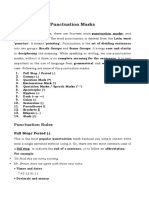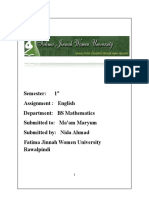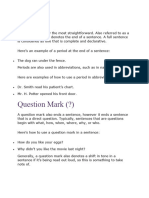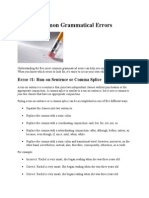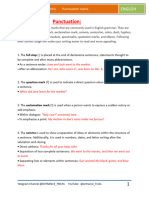A Rough Guide To Punctuation
A Rough Guide To Punctuation
Uploaded by
aminM1977Copyright:
Available Formats
A Rough Guide To Punctuation
A Rough Guide To Punctuation
Uploaded by
aminM1977Original Title
Copyright
Available Formats
Share this document
Did you find this document useful?
Is this content inappropriate?
Copyright:
Available Formats
A Rough Guide To Punctuation
A Rough Guide To Punctuation
Uploaded by
aminM1977Copyright:
Available Formats
A Rough Guide to Punctuation
The Learning Centre http://www.lc.unsw.edu.au Good punctuation is crucial for successful academic writing. Many students essays use little punctuation beyond commas and full stops. But to be restricted to just two forms of punctuation mark, when writing your essay, is like building a house using only a hammer and a saw: you can do it; but not very well. By learning to use more, or all, of the available forms of punctuation you will be able to communicate and express your ideas, and arguments, more clearly.
Full Stop (.)
Full stops have three distinct uses: 1. To mark the end of a sentence 2. To indicate abbreviated words (unless first and last letters of the word are shown). 3. To punctuate numbers and dates
Examples:
The cat is completely black. The teacher will be John Smith (B. Sci.). All assignments should be submitted by 6. 6. 03.
Colon (:)
A colon can be used to indicate that a list, quotation or summary is about to follow. A colon can also be used to separate an initial sentence/clause from a second clause, list, phrase or quotation that supports the first in a particular way.
Examples: Buy these things: a packet of peanuts, two loaves of bread and a kilogram of steak. Writing an assignment is not easy: to begin with you have to do a lot of research. The Television set, as the icon of the information age, represents the realisation of a dream for humankind: that knowledge and experience can be transmitted and shared across the boundaries of time and space.
Semicolon (;)
Separates two complete sentences that are closely linked. The semicolon can be replaced by a full stop, but the direct link between the two parts is lost. A semicolon also serves as a second level of punctuation in a series of words or phrases which already have commas, making some internal divisions.
Examples: To err is human; to forgive, divine. Dont go near the lions; they could bite you. She came out of the house, which had a long drive, and saw the police officer at the end of the path; but instead of continuing towards him, she hid until he left. Examples: dont (do not) Itll (It will) shell (she will)
Apostrophe ()
There are two uses for the apostrophe: 1. Contractions A contraction is a shortened version of a word. An apostrophe is used to show that something has been left out, and where it has been left out. 2. Possessives An apostrophe is used to indicate ownership/ possession with nouns. To show ownership by a single individual, insert the apostrophe between the noun and the s. To show ownership by more than one individual, use the apostrophe at the end of the word. Be careful: Its is the contraction of it is. Its is not a possessive (a possessive denotes ownership).
Its too cold to go swimming today. I dont think shell come to the party. the dogs tail (belonging to a single dog) the womens magazines boys football boots (belonging to more than one boy) Einsteins theory of relativity The dog is chasing its own tail!
Question Mark (?)
A question mark is used at the end of a sentence which is a question.
Example: Have the students completed the exam?
Comma (,)
Commas are used in longer sentences to separate information into readable units. A single comma ensures correct reading of a sentence which starts with a long introductory element. Pairs of commas help in the middle of a sentence to set off any string of words which is either a parenthesis, or in contrast, to whatever went before. A set of commas is a means of separating items in a list within a sentence. Sometimes a comma is needed between the last two items to ensure clarity.
Example: When Australia celebrated its sesquicentenary in 1938, there was a little of the confidence or enthusiasm of the centennial celebrations of 1888. Yet in representing ourselves to ourselves, as film and television do, these media are constantly introducing and reinforcing the assumptions.
The details required are name, date of birth, address and telephone number. The main divisions of the economy are agriculture, manufacturing, and service industries.
Hyphen (-)
When used correctly, a hyphen links two or more words, that normally would not be placed together, in order that they work as one idea and these are called compound nouns.
Examples: Stoniers post-industrial economy is a service economy. There are four types of information-related machines.
Dashes ()
Hyphens are not the same as dashes. Dashes are like brackets; they enclose extra information. A colon and semi-colon would work just as well in the example opposite. Dashes are rarely used in academic writing. Although often used in pairs, dashes can also be used singularly.
Examples: To the three divisions of the economyagriculture, manufacturing, and service industriesJones has added a fourth. Have an orangeor would you prefer a banana? While the importance of sport to Pay TV is clear, the opposite perspective is less certainthe importance of Pay TV to sport. Example: It was unusual to see Paul awake so early (as he often studied late into the night) and Jane greeted him with amazement. Larsen and Greene (1989) studied the effects of pollution in three major cities. Australia is a settler society (Hudson & Bolton 1997, p. 9).
Parentheses ( )
Parentheses are brackets used to include extra or nonessential material in sentences. Parentheses should be used sparingly and always appear in pairs. In citation systems like Harvard, parentheses are used to include in-text references.
Exclamation Mark (!)
An exclamation mark is used at the end of a sentence and indicates surprise, anger, or alarm. Exclamation marks should be used very sparingly and are not often used in academic writing.
Example The police stormed in and arrested her! How disgraceful!
Ellipsis ( ... )
An ellipsis consists of three full stops. It indicates that material has been left out of a quotation. When quoting, it is sometimes necessary to leave out words or lines for reasons of relevance or length. Using an ellipsis makes any omissions known to your reader.
Example: But to be restricted to just two forms of punctuation mark ... is like building a house using only a hammer and a saw: you can do it; but not very well.
Prepared by Prepared by Ian Collinson, Pam Mort & Tracey-Lee Downey for The Learning Centre, The University of New South Wales 2011. This guide may be distributed for educational purposes and adapted with proper acknowledgement.
You might also like
- What Are The 14 Punctuation Marks in English GrammarDocument4 pagesWhat Are The 14 Punctuation Marks in English GrammarSherwin Phillip100% (1)
- A Rough Guide To Punctuation: The Learning Centre - HTTP://WWW - Lc.unsw - Edu.auDocument2 pagesA Rough Guide To Punctuation: The Learning Centre - HTTP://WWW - Lc.unsw - Edu.auAsmaa BaghliNo ratings yet
- Simple Guide To PunctuationDocument2 pagesSimple Guide To PunctuationBrian RogersNo ratings yet
- Simple Guide To PunctuationDocument2 pagesSimple Guide To Punctuationrakesh_danduNo ratings yet
- PunctuationDocument3 pagesPunctuationJULIAN CARDENASNo ratings yet
- Punctuation 123Document11 pagesPunctuation 123morebandu2483No ratings yet
- Punctuation RulesDocument12 pagesPunctuation Rulesجنة الورودNo ratings yet
- PanctuationDocument5 pagesPanctuationabdoapple477No ratings yet
- Punctuations and Its Proper UseDocument34 pagesPunctuations and Its Proper UseCha Jahzeel SamboNo ratings yet
- Taccoed Campus: Adekunle Ajasin UniversityDocument9 pagesTaccoed Campus: Adekunle Ajasin UniversityPrecious JohnNo ratings yet
- Punctuation:: 1. Period/Full Stop (.)Document6 pagesPunctuation:: 1. Period/Full Stop (.)Wajeeha NadeemNo ratings yet
- DocumentDocument5 pagesDocumentnaol feyissaNo ratings yet
- Punctuation Marks: Full Stop / Period (.)Document5 pagesPunctuation Marks: Full Stop / Period (.)Hitesh MishraNo ratings yet
- English IDocument30 pagesEnglish Irac.he.l.a.mnao.aNo ratings yet
- Punctuation MarksDocument8 pagesPunctuation MarksTriceNo ratings yet
- Research MaterialsDocument7 pagesResearch MaterialsPrecious JohnNo ratings yet
- There Are 14 PuDocument4 pagesThere Are 14 PuHello HiNo ratings yet
- Punctuation MarksDocument8 pagesPunctuation MarksmichelanhojuniorNo ratings yet
- Punctuation Marks in EnglishDocument9 pagesPunctuation Marks in EnglishHerson RamirezNo ratings yet
- Punctuation ColorDocument3 pagesPunctuation Colorrya336437No ratings yet
- Punctuation and CapitalizationDocument13 pagesPunctuation and CapitalizationrashmipohoNo ratings yet
- Punctuation - Signs and SymbolsDocument9 pagesPunctuation - Signs and SymbolsSachin PratapNo ratings yet
- PUNCTUATIONSDocument16 pagesPUNCTUATIONSJen ValenciaNo ratings yet
- Punctuation • 7ESLDocument14 pagesPunctuation • 7ESLOmar BoulalNo ratings yet
- What Are The 14 Punctuation Marks in English GrammarDocument5 pagesWhat Are The 14 Punctuation Marks in English GrammarJiménez MilenaNo ratings yet
- Allama Iqbal Open University, Islamabad: (Department of Secondary Teacher Education)Document26 pagesAllama Iqbal Open University, Islamabad: (Department of Secondary Teacher Education)ExpressNo ratings yet
- Sentence Endings: When Did Jane Leave For The Market?Document4 pagesSentence Endings: When Did Jane Leave For The Market?nameNo ratings yet
- Lesson 3 Punctuation Marks and Capitalization Grade 9Document26 pagesLesson 3 Punctuation Marks and Capitalization Grade 9Eimielle Nicole100% (1)
- PunctuationDocument5 pagesPunctuationsara.tasnim.bngNo ratings yet
- Use of PunctuationDocument8 pagesUse of PunctuationKhan SahbNo ratings yet
- Eng-301 (Group 3) Assignment Punctuation & Their UsesDocument9 pagesEng-301 (Group 3) Assignment Punctuation & Their UsesUrooj FatimaNo ratings yet
- Punctuation Marks: ST. JOSEPH SCHOOL, Addis Ababa English Grammar For Grade-10 Week FourtheenDocument4 pagesPunctuation Marks: ST. JOSEPH SCHOOL, Addis Ababa English Grammar For Grade-10 Week FourtheenYAbidiNo ratings yet
- PunctuationsDocument6 pagesPunctuationsmsaeedafd13No ratings yet
- The Comma (,) : The Comma Is Useful in A Sentence When The Writer Wishes ToDocument8 pagesThe Comma (,) : The Comma Is Useful in A Sentence When The Writer Wishes ToZarin Ren JohariNo ratings yet
- 14 Punctuation Marks in English GrammarDocument5 pages14 Punctuation Marks in English GrammarMarilyn PadojinogNo ratings yet
- Punctuation Marks, Comma, Colon..Document5 pagesPunctuation Marks, Comma, Colon..Joseph BalasinghamNo ratings yet
- What Are The 14 Punctuation Marks in English Grammar?: Sentence EndingsDocument5 pagesWhat Are The 14 Punctuation Marks in English Grammar?: Sentence EndingsJesusa Caunan VenzonNo ratings yet
- How To Write A Paragraph WellDocument13 pagesHow To Write A Paragraph Wellnga TrầnNo ratings yet
- ENRIQUEZ - Mechanics in WritingDocument40 pagesENRIQUEZ - Mechanics in WritingKyla EnriquezNo ratings yet
- Punctuation Rules: John Was Hurt He Knew She Only Said It To Upset HimDocument3 pagesPunctuation Rules: John Was Hurt He Knew She Only Said It To Upset HimSalcedo Romeo100% (1)
- NidaDocument11 pagesNidaNida AhmedNo ratings yet
- Symbol For Punctuation Mark Name of Punctuation MarkDocument4 pagesSymbol For Punctuation Mark Name of Punctuation MarkJoshua JosephNo ratings yet
- English DocumentdocxDocument13 pagesEnglish Documentdocxhawk ckaiNo ratings yet
- Punctuation Comma:: SemicolonDocument2 pagesPunctuation Comma:: SemicolonSufyan AshrafNo ratings yet
- Subordinate Conjunctions: (Subordinate Conjunctions Connect Two Unequal Parts, E.g., Dependent and Independent Clauses)Document12 pagesSubordinate Conjunctions: (Subordinate Conjunctions Connect Two Unequal Parts, E.g., Dependent and Independent Clauses)Anonymous vXa784No ratings yet
- Puntuation MarksDocument6 pagesPuntuation MarksSHEBA RAE ESPERANZANo ratings yet
- Full Stop or PeriodDocument11 pagesFull Stop or PeriodAbiR.CimaNo ratings yet
- 5 Most Common Grammatical Errors: Error #1: Run-On Sentence or Comma SpliceDocument15 pages5 Most Common Grammatical Errors: Error #1: Run-On Sentence or Comma SpliceJaneNo ratings yet
- Different Hair StyleDocument7 pagesDifferent Hair StyleChenie Dugan MativoNo ratings yet
- PunctuationDocument22 pagesPunctuationUmroMostafaNo ratings yet
- USES of PunctuationDocument6 pagesUSES of PunctuationMarkdanielRamiterreNo ratings yet
- There Are 14 Punctuation Marks That Are Commonly Used in English GrammarDocument3 pagesThere Are 14 Punctuation Marks That Are Commonly Used in English GrammarAamirNo ratings yet
- What Are The 14 Punctuation Marks in English GrammarDocument3 pagesWhat Are The 14 Punctuation Marks in English GrammarJune Soriano100% (1)
- Punctuations NotesDocument6 pagesPunctuations NotesDivisha AgarwalNo ratings yet
- TWB WK 7Document34 pagesTWB WK 7Mcrey Garilao BuncagNo ratings yet
- Punctuation MarksDocument7 pagesPunctuation Marksmarkosmark575No ratings yet
- Quotation Marks: Punctuation Punctuation Is One Component of Writing That People Seldom Think About orDocument10 pagesQuotation Marks: Punctuation Punctuation Is One Component of Writing That People Seldom Think About orMiguel Zay DanielNo ratings yet
- Information About Punctuation FromDocument4 pagesInformation About Punctuation FromAtiqullah AfghanNo ratings yet





